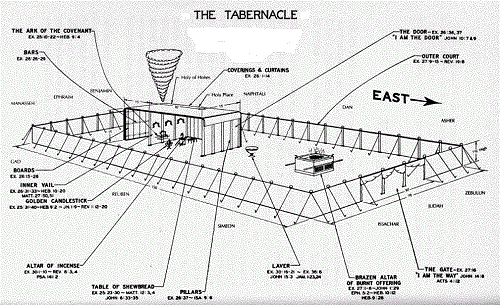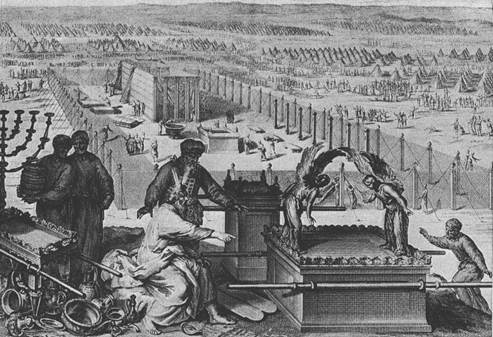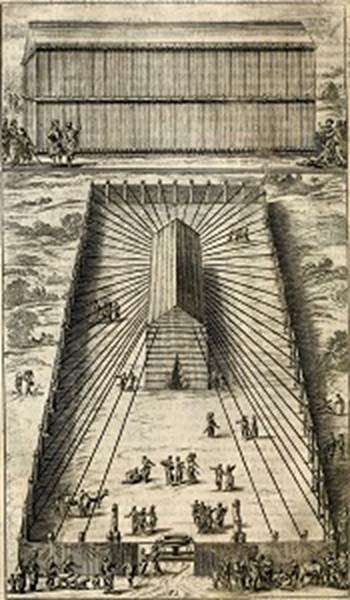Hebrew Tabernacle
also called
Tent of the Congregation / Tent of Meeting
Compiled by WD Kemner May 2025
Wikipedia does such a fantastic definition of the tabernacle.
https://en.wikipedia.org/wiki/Tabernacle
This is an “excerpt” from that site:
According to the Hebrew Bible, the tabernacle (Hebrew: מִשְׁכָּן, romanized: miškān, lit. 'residence, dwelling place'), also known as the Tent of the Congregation (Hebrew: אֹהֶל מוֹעֵד, romanized: ʔohel mōʕēḏ, also Tent of Meeting), was the portable earthly dwelling of God used by the Israelites from the Exodus until the conquest of Canaan. Moses was instructed at Mount Sinai to construct and transport the tabernacle with the Israelites on their journey through the wilderness and their subsequent conquest of the Promised Land. After 440 years, Solomon's Temple in Jerusalem superseded it as the dwelling-place of God.
The main source describing the tabernacle is the biblical Book of Exodus, specifically Exodus 25–31 and 35–40. Those passages describe an inner sanctuary, the Holy of Holies, created by the veil suspended by four pillars. This sanctuary contained the Ark of the Covenant, with its cherubim-covered mercy seat. An outer sanctuary (the "Holy Place") contained a gold lamp-stand or candlestick. On the north side stood a table, on which lay the showbread. On the south side was the Menorah, holding seven oil lamps to give light. On the west side, just before the veil, was the golden altar of incense. It was constructed of 4 woven layers of curtains and 48 15-foot tall standing wood boards overlaid in gold and held in place by its bars and silver sockets and was richly furnished with valuable materials taken from Egypt at God's command.
A detailed description of a tabernacle, located in Exodus chapters 25–27 and Exodus chapters 35–40, refers to an inner shrine, the Holy of Holies, housing the ark, and an outer chamber with the six-branch seven-lamp Temple menorah, table for showbread, and an altar of incense. An enclosure containing the sacrificial altar and bronze laver for the priests to wash surrounded these chambers.
The detailed outlines for the tabernacle and its priests are enumerated in the Book of Exodus:
Exodus 25: Materials needed: the Ark, the table for 12 showbread, the menorah.
Exodus 26: The tabernacle, the bars, partitions.
Exodus 27: The copper altar, the enclosure, oil.
Exodus 28: Vestments for the priests, ephod garment, ring settings, the breastplate, robe, head-plate, tunic, turban, sashes, pants.
Exodus 29: Consecration of priests and altar.
Exodus 30: Incense altar, washstand, anointing oil, incense.
Builders
In Exodus 31, the main builder and maker of the priestly vestments is specified as Bezalel, son of Uri son of Hur of the tribe of Judah, who was assisted by Oholiab and a number of skilled artisans.
Plan
During the Exodus, the wandering in the desert and the conquest of Canaan, the Tabernacle was in part a portable tent, and in part a wooden enclosure draped with ten curtains, of blue (tekhelet תְּכֵלֶת), purple (’argāmān אַרְגָּמָן), and scarlet (šānî שָׁנִי) fabric. It had a rectangular, perimeter fence of fabric, poles and staked cords. This rectangle was always erected when the Israelite tribes would camp, oriented to the east as the east side had no frames. In the center of this enclosure was a rectangular sanctuary draped with goat-hair curtains, with the roof coverings made from rams' skins.
Holy of Holies
Beyond this curtain was the cube-shaped inner room, the Kodesh Hakedashim (Holy of Holies). This area housed the Ark of the Covenant, inside which were the two stone tablets brought down from Mount Sinai by Moses on which were written the Ten Commandments, a golden urn holding the manna, and Aaron's rod which had budded and borne ripe almonds (Exodus 16:33–34, Numbers 17:1–11, Deuteronomy 10:1–5; Hebrews 9:2–5).
This is the END OF Wikipedia definition of the tabernacle.
See the FULL information at the website: https://en.wikipedia.org/wiki/Tabernacle
-----------------------------------
There are a lot of pictures and diagrams in the public domain. Here are a few.
The Design and Layout of the Tabernacle.
Source: Public Domain
When the Israelites would make camp, the tabernacle was center with each tribe in a specific location around it.
“The erection of the tabernacle and the Sacred vessels”
from the 1728 Figures de la Bible, Gerard Hoet
Another resource outside the Book of Exodus in the Bible is the Jewish Historian Flavis Josephus.
In his Complete Works Book II Chapter VI of Antiquities of the Jews he gives an account of the Tabernacle. Josephus (37-100 A.D.) wrote his history of the Jews and it has been reproduced many times over the centuries. The 1683 edition of his work included sketches of the tabernacle equipment and this one of the Tabernacle.
Source: https://archive.org/stream/worksofjosephus00jose/worksofjosephus00jose#page/n101/mode/1up
The Book of Hebrews beginning with Chapter 9, the Apostle Paul begins to compare the Jewish Tabernacle to Jesus Christ.
SEE ALSO THE SPECIAL TOPIC: NEW COVENANT versus OLD COVENANT


